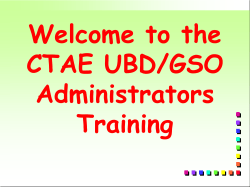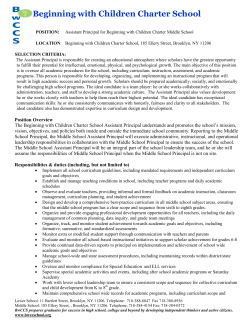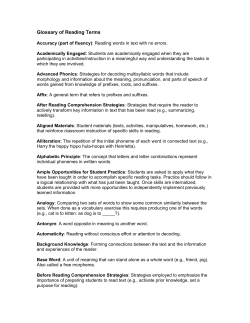
Instructional Capacity: How to Build it Right Handout 1
Handout 1 October 2013 | Volume 71 | Number 2 Leveraging Teacher Leadership Pages 56-61 Instructional Capacity: How to Build it Right Ann Jaquith To improve teaching and learning, teachers must take advantage of all the instructional resources in their schools. Here's how principals can help teachers lead this work. Principals can increase the instructional capacity of their schools by creating opportunities for teachers to collaborate as they use key resources to improve teaching and learning. This is easier said than done. 1 To illustrate, let's look at how principals in two schools I studied organized teachers to work together. These urban middle schools, which are located in the same school district and serve similarly diverse student populations, provide portraits of different approaches to organizing teacher learning. One common approach creates an organizational structure to enable teacher collaboration but falls short of changing teachers' ideas about how to use instructional resources or supporting teachers in making instructional changes. A second approach builds instructional capacity that leads to the ongoing generation of more effective instructional resources. Liberty Middle School: What's Wrong with This Picture? At Liberty Middle School, teachers met with their grade-level, subject-area "partners" once a week during the school day and with their subject-area colleagues once a month after school. The Liberty principal had reorganized school structures so teachers were less isolated from one another. She believed that an excellent education combined responsiveness to students' needs with social equity. She thought caring and respectful student–teacher relationships were crucial to student success. She also believed that the principal's job was to create organizational structures for teacher collaboration and provide many opportunities for professional development—then stay out of the way and let teachers do their job. At Liberty, teachers' meetings occurred in relative isolation. Teachers met in individual classrooms, and administrators didn't participate. Every department had three pairs of teaching partners, who were expected to develop common summative assessments and administer these to their students at the end of each unit. According to one teacher, they had "all the leeway [they] wanted in terms of curriculum; nothing [was] mandated." Many teachers liked this autonomy, and teaching pairs typically approached their instruction of curricular units differently. They set their own meeting agendas, designed the focus of their collaborative work, and rarely discussed how they approached instruction. The teachers attended some thoughtful professional development on literacy, but they never worked together in their meetings on using any of the suggested instructional strategies. Although teachers had autonomy over how they spent their collaborative time, most teaching partners used this time to construct end-of-unit summative assessments. The three teams I observed designed their assessments to mirror the format of the California State Test (CST). These teachers typically developed their unit assessments by culling premade questions that were similar to the multiple-choice questions on the CST from a commercial database the principal purchased for this purpose. Even though teacher partner meetings occurred in relative isolation at Liberty, their form and substance were remarkably similar. Look in on any language arts or history teacher collaborative planning meeting, and you'd probably see a pair of teachers sitting in front of a computer screen; they'd be scanning a databank of assessment questions organized by content-area standards, trying to identify the most appropriate test questions to use. Permission granted by ASCD for up to 50 electronic copies via email attachment. (http://www.ascd.org/Publications/Permissions/Permissions-FAQ.aspx#no15) Cedar Bridge Middle School: Getting It Right At Cedar Bridge, the entire staff—teachers and administrators—gathered in the library on a Monday afternoon to work together in small groups. A poster of Richard DuFour's four essential questions for professional learning communities hung on the library wall: What do we want students to learn? How will we know if students have learned it? What will we do if students don't learn? What will we do if they do? Nearby a sign offered this advice: "This work should be relevant and manageable." The principal framed the work that teacher teams would engage in that afternoon: "We want to focus on nonsummative assessments to figure out exactly [what and] how our students are learning." Small groups of teachers, organized by grade level and subject area, were seated around rectangular tables with student work— essays, math problems, and science lab write-ups—spread out in front of them. Cedar Bridge's five school administrators were sprinkled among the teacher groups, but they were indistinguishable from the teachers, who were reading student work and looking for evidence of understanding. At this meeting, the 6th grade humanities teachers worked together to assess the efficacy of a reading strategy— talking-to-the-text—that they used to teach the novel that their 6th graders were reading—Christopher Paul Curtis's The Watsons Go to Birmingham—1963 (Yearling, 1997). The teachers had been introduced to this strategy in a professional development program that Liberty had also participated in. Unlike at Liberty, however, they were expected and supported to use this strategy in their instruction. Teachers read and discussed the 6th grade samples of talking-to-the-text, which consisted of' comments and questions that students had written on sticky notes and placed inside the pages of the novel. The administrator sitting with this team asked the teachers how they were using the talking-to-the-text strategy and what students' "text-talk" revealed about their understanding. One teacher described how she used students' talk to focus class discussion and find out what was unclear to her students. "During a confusing chapter," the teacher explained, "I had students keep the sticky notes in the book, and I looked through them … and picked out five common questions (or observations) … which laid the foundation for the next class discussion." For example, many students asked about Wool Pooh, a scary character invented by the narrator's brother to deter children from swimming in a dangerous place (Wool Pooh—think whirlpool). Others students wondered whether the main character—9-year-old Kenny—believed in ghosts. Students' text-talk also clarified that many students found the description of the bombing of the Birmingham church confusing. Teachers discovered that looking over the sticky notes was a useful way to see students' thinking—and this became a refined use of this strategy. Other teachers suggested other approaches. One pointed out that she had students discuss their text-talk questions and observations with one another in small groups. A first-year teacher in the group asked how the teachers helped students who struggled to "talk to the text." One colleague replied, "I have the students read aloud to me and tell me their thoughts and questions. Then I prompt them to write those comments down." Like all teacher groups in the library that afternoon, the 6th grade humanities team analyzed students' work to develop a common lesson to teach in their classrooms that week. They also developed common criteria for assessing the student work that would result. The teachers would then look at that new work to determine how well students had understood the lesson's focal concept or skill. Collectively, they would decide on their next instructional moves. One move they discussed was to have students make a list of how each character in the novel reacted to the church bombing. They also considered what they could do to help students become alert to the use of figurative language, which the novel is rich in. Another instructional move they debated concerned a chapter that most students found confusing. The teachers thought it might be a good idea to read the chapter out loud and then ask students to reread it to themselves and talk to the text. The teachers' common lesson plans grew out of these instructional conversations. This cycle of developing common lessons rooted in teachers' collective examination of students' work occurred five times during the year. Defining Instructional Capacity Principals at both Liberty and Cedar Bridge were committed to improving student learning outcomes, and they viewed teacher collaboration as a means to this end. Each principal set aside time for teachers to work together, and each defined joint tasks for teachers to work on to improve student learning. However, the tasks and structure of teachers' collaborative work in the two schools differed considerably. These differences affected the extent to which each school generated instructional capacity. Principals are more likely to exert the sort of leadership we saw at Cedar Bridge when they clearly understand what instructional capacity means. Instructional capacity refers to the collection of resources for teaching that a district, school, or grade-level or subject-area team has to support instruction and, most important, the ability to effectively use these resources to engage students and deepen learning. A school needs four types of instructional resources: Instructional knowledge (knowledge of content, pedagogy, and students). Instructional toolsormaterials (curriculum, teaching materials, and assessments). Instructional relationships characterized by trust and mutual respect. Organizational structures that promote the use of various instructional resources, such as common learning time for teachers and formal instructional leadership roles. School leaders need to know where these four types of instructional resources reside within their schools and how they interact. They also need to know how to create opportunities for teachers to use these resources to improve teaching and learning. How to Build Instructional Capacity So how can school leaders guide teachers in making the most of these four instructional resources to build instructional capacity in their schools? The following practices can help. Create the Right Structures How principals conceptualize, organize, and provide professional learning experiences for teachers can influence the type of instructional resources that schools typically use. For instance, at Cedar Bridge, administrators were tapped as an instructional resource. In addition, the teachers' own instruction—represented by joint lesson plans and the resulting student work—became a source for their ongoing learning. Leaders at Cedar Bridge also provided an overarching structure for teachers' learning—teachers and administrators met five times during the school year to develop common lessons on the basis of collective examination of student work. Moreover, the leaders designed a role for themselves in this process and continually adjusted the learning design to better meet team needs during the year. For example, provided with results from the district benchmark test, teachers at Cedar Bridge were asked to identify a common student misunderstanding and design a lesson together to address it. Administrators immediately recognized that teachers perceived a disjunction between what the district test was assessing (for instance, punctuation and grammar rules) and what they were trying to teach (that is, reading for understanding and writing evidence-based arguments). So they abandoned their focus on standardized test data and replaced it with a different focus—students' performance on class assignments. Administrators at Cedar Bridge continued to hone the purpose of the professional learning meetings, asking teachers to zero in on the groups of students who were consistently underperforming. At one meeting, the principal asked teachers to look specifically at the performance of their black students. Then teachers were asked to write a reflection that answered this question: "What did you observe about your black students that informed your lesson on the spot or will inform future instruction?" As the year progressed, administrators repeatedly asked, "How can we better serve our black students?" Paradoxically, even though the teachers at Liberty had autonomy for designing their collaboration time, their work together produced uniform outcomes in the form of CST-like end-of-unit assessments. In contrast, the teacher teams at Cedar Bridge created unique formative assessments (essays, outlines, and analytic arguments supported by textual evidence) customized to their particular grade-level and subject-matter learning goals. Consequently, we see that how workplace learning is designed for teachers affects what teachers focus on and are likely to learn, which, in turn, has consequences for how teachers design instruction. The two school vignettes provide an image of principals as important architects of teachers' learning and reveal how principals' actions can stimulate (or thwart) the creation of instructional capacity in schools. Create the Right Conditions School leaders must create conditions that enable teachers to learn from others and incorporate others' expertise into their own instructional repertoire. For instance, at Cedar Bridge, it was easier for teachers and administrators to observe and learn from one another because all teacher teams met in the same space. Administrators also structured opportunities to share work across teams. It quickly became a norm for teachers to bring student work samples and assessment criteria to these meetings and to look at one another's samples. As a result, good learning practices spread among teacher teams. Moreover, everyone saw that the principal sat with teacher teams, looked at student work, and asked questions about evidence of student learning. In so doing, he modeled a way of engaging in professional learning. In the two school vignettes, we see several moves that principals can make to stimulate instructional capacity—for example, to expect and support the use of specific instructional strategies and provide feedback to teams on their work. We also see the limitations of merely creating organizational structures that enable teacher collaboration. Establishing time for teacher collaboration can be, in itself, a challenging undertaking if districts don't work with teachers unions to bargain for teacher collaboration time. Also, as these examples show, organizational structures alone are insufficient to promote change in teachers' instructional practice. Simply having time together doesn't guarantee that teacher conversations will focus on instruction or student learning. Create the Right Expectations Principals can create the expectation that teachers will engage in work that requires collaboration and learning. Although the principal at Liberty set the conditions for interdependent work by having teachers create and use a common assessment for their curricular units, she didn't structure or guide teachers' interactions. Cedar Bridge created conditions that fostered learning and teamwork by expecting teachers to look collaboratively at student work products and analyze student learning to jointly develop lessons. In addition, Cedar Bridge strengthened shared responsibility for both adult and student learning by convening a team, composed of administrators and an instructional coach, to reflect on teachers' learning and provide feedback on their work. Create the Right Kind of Teams Assembling teams with distributed expertise and relevant knowledge goes a long way toward building an instructional improvement culture. Leaders need to make sure that the requisite expertise is represented on a team and make adjustments if it isn't. Principals can include knowledgeable staff, such as administrators or coaches, on teacher teams; or they can expand the focus of teachers' work to include teachers from other grade levels who possess needed expertise. Principals can also broaden a team's collective knowledge base by working strategically with external partners who have this requisite knowledge. For example, principals at both Cedar Bridge and Liberty partnered with a professional development organization that focused on providing language and literacy instruction to black and Latino students. For principals, particularly those who work in schools with large proportions of inexperienced teachers, paying attention to team composition is important in designing teams that have the capacity to learn together. Create a Learning Focus At Cedar Bridge, teachers were expected to look at student work for evidence of learning and coplan lessons and formative assessments from their collaborative analysis of student work. Administrators participated in and modeled this process. As a result, Cedar Bridge teachers made intentional and incremental changes to their instructional practice with each lesson they planned together. Teachers began to use particular instructional strategies, like talking-to-the-text; over time they honed their use of these strategies and developed a shared instructional repertoire. This was not the case at Liberty. Although teachers discussed what they wanted students to learn, no team examined student work, discussed student learning on the basis of assessment results, or shared instructional approaches as they constructed common assessments. The absence of instructional conversations at Liberty led one teacher to say, "There are pockets of people who are dedicated to collaboration [but] not a lot of people" act collaboratively. For this teacher, Liberty espoused collaboration "orally," with most teachers just feeling as though they didn't have time for it. Need Help with Processes? Assemble a Team To help leaders think more strategically about how to organize effective learning processes for their teachers, leaders can assemble an instructional leadership team composed of administrators and teachers. The size of the team will vary depending on the school, but members should have expertise relevant to the team's purpose, including knowledge of instruction and knowledge of students—and team members should be recognized by colleagues for this expertise. The principal and team members may find it helpful to consider where on the process knowledge spectrum a 2 school's particular instructional problem is situated. Developed by organizational scholar Amy Edmondson, the process knowledge spectrum defines three types of work processes: routine operations, complex operations, and innovation operations. Edmondson places routine operations that require highly repetitive work, such as the work of call centers or the workflows in fast-food restaurants, at one end of the spectrum. At the other end are innovative operations that require research and discovery, such as curing a rare form of cancer. In between routine and innovative operations are what Edmondson calls complex operations. Operations are complex when some of the process knowledge (such as effective classroom management techniques or teaching phonemic awareness) is known but much of the knowledge about what to do to achieve a desired result (for example, promoting deep understanding of disciplinary concepts or perceptive and critical reading skills) is still unknown or changes depending on a dynamic set of variables, like who the students are and what their background knowledge is. Under such circumstances, working in teams becomes an invaluable approach to making better decisions and improving performance—provided that teams are designed for learning. I saw such teams at Cedar Bridge. Principals Need Support, Too Creating the conditions in schools to ensure that ambitious and engaging teaching occurs in every classroom every day is its own complex process. Principals need to know how to build, lead, and support teams of instructional experts who can combine their expertise, conduct teaching experiments, learn together from these experiments, and continually improve instruction. Given the dynamic context of schools, central offices have an important role to play. They must create district learning conditions that support school leaders as they work with teams to generate the instructional capacity our schools need. Author's note: School names are pseudonyms. Endnotes 1 These vignettes are a composite of observation and interview data collected as part of a qualitative study I conducted during the 2007–08 school year. Data collection and analysis included observations of 43 teacher meetings, 23 classroom observations, 22 interviews, and 108 hours of professional development observations in which teachers from both schools participated. I analyzed this data in my 2009 doctoral dissertation, The Creation and Use of Instructional Resources: The Puzzle of Professional Development, Stanford University, California. 2 For more information on creating effective teams and on the process knowledge spectrum, see Edmondson, A., (2012). Teaming: How Organizations Learn, Innovate, and Compete in the Knowledge Economy (San Francisco: Wiley & Sons). Ann Jaquith is a senior researcher and director of Linked Learning at Stanford Center for Opportunity Policy in Education, Stanford University, Stanford, California. Copyright © 2013 by ASCD
© Copyright 2025




















